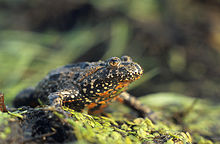Toad
| Toads | |
|---|---|

| |
| European fire-bellied toad (Bombina bombina) | |
| Scientific classification | |
| Kingdom: | |
| Phylum: | |
| Subphylum: | |
| Class: | |
| Order: | |
Toad is a common name for certain frogs, especially of the family Bufonidae, that are characterized by dry, leathery skin, short legs, and large bumps covering the parotoid glands.[1][2]
A distinction between frogs and toads is not made in scientific taxonomy, but is common in popular culture (folk taxonomy), in which toads are associated with drier skin and more terrestrial habitats.[3]
Biology
In scientific taxonomy, toads are found in the families Bufonidae, Bombinatoridae, Discoglossidae, Pelobatidae, Rhinophrynidae, Scaphiopodidae and Microhylidae.[4]
Usually the largest of the bumps on the skin of a toad are those that cover the parotoid glands. The bumps are commonly called warts, but they have nothing to do with pathologic warts, being fixed in size, present on healthy specimens and not caused by infection.[5][unreliable source?] Frogs travel from non-breeding to breeding areas of ponds and lakes. Bogert (1947) suggests that the toads' call is the most important cue in the homing to ponds. Toads, like many amphibians, exhibit breeding site fidelity (philopatry). Individual American toads return to their natal ponds to breed where they are likely to encounter siblings as potential mates. Although inbred examples within a species is possible, siblings rarely mate.[6] Toads recognize and avoid mating with close kin. Advertisement vocalizations given by males appear to serve as cues by which females recognize kin.[7] Kin recognition thus allows avoidance of inbreeding and consequent inbreeding depression.
In human culture
In Kenneth Grahame's 1908 novel The Wind in the Willows, Mr. Toad is a likeable and popular, if selfish and narcissistic, comic character. Mr. Toad reappears as the lead character in A. A. Milne's 1929 play Toad of Toad Hall, based on the book.[8][9]
Mr. Toad's Wild Ride, originally planned as a roller coaster but adapted by Walt Disney as a family-friendly dark ride, is one of the few Disneyland attractions operational since the park's opening in 1955. The ride is based on the 1949 film The Adventures of Ichabod and Mr. Toad, itself developed (in part) from Grahame's 1908 novel. A Magic Kingdom version of the ride operated upon the park's Orlando, Florida, opening in 1971, but was closed and replaced by The Many Adventures of Winnie the Pooh in 1998.
In Chinese culture, the Money Toad (or Frog) Jin Chan appears as a Feng Shui charm for prosperity.[10]
See also
References
- ^ "toad". The American Heritage Dictionary of the English Language. Houghton Mifflin Harcourt. Retrieved 6 October 2016.
- ^ "toad | amphibian". Encyclopedia Britannica. Retrieved 2017-05-23.
- ^ "Toad". Dictionary.com, LLC. Retrieved 29 May 2012.
- ^ "Anura, Taxonomic Serial No.: 173423". ITIS Report. Integrated Taxonomic Information System. Retrieved 20 April 2012.
- ^ Ray, Crystal. "Do Toads Really Cause Warts". Yahoo!. Archived from the original on 29 July 2014. Retrieved 29 January 2013.
{{cite web}}: Unknown parameter|deadurl=ignored (|url-status=suggested) (help) - ^ "American Toad". psu.edu.
- ^ Waldman B, Rice JE, Honeycutt RL. Kin recognition and incest avoidance in toads. Am. Zool. 1992. 32:18-30.
- ^ "The Big Read Top 200". BBC. April 2003. Retrieved 28 June 2016..
- ^ Christine Paik (2002-03-19). "NPR report". NPR. Retrieved 2013-02-26.
- ^ "Feng Shui Money Frog". Retrieved 28 June 2016.
External links
- . Encyclopædia Britannica. Vol. 26 (11th ed.). 1911. p. 1035.
